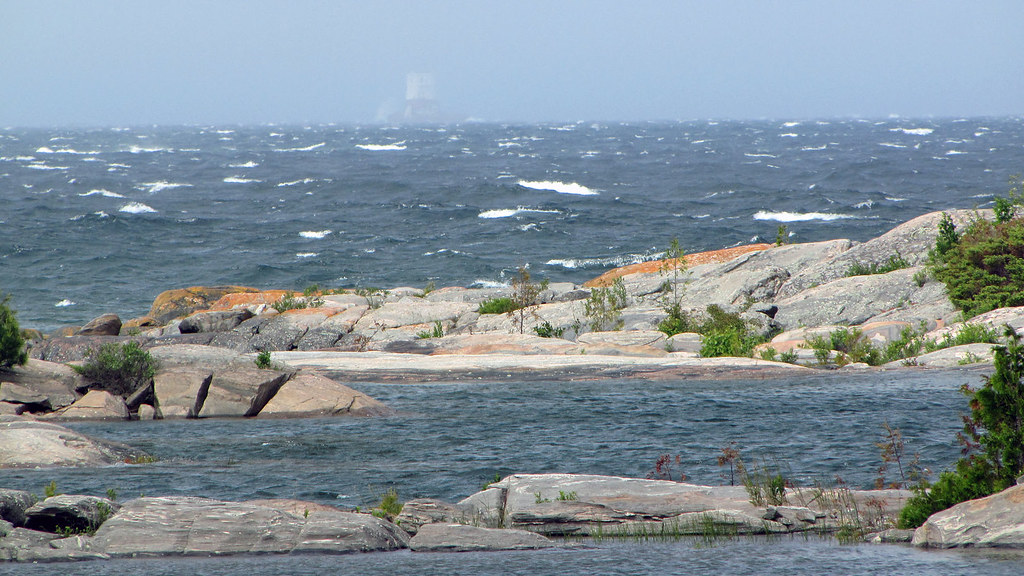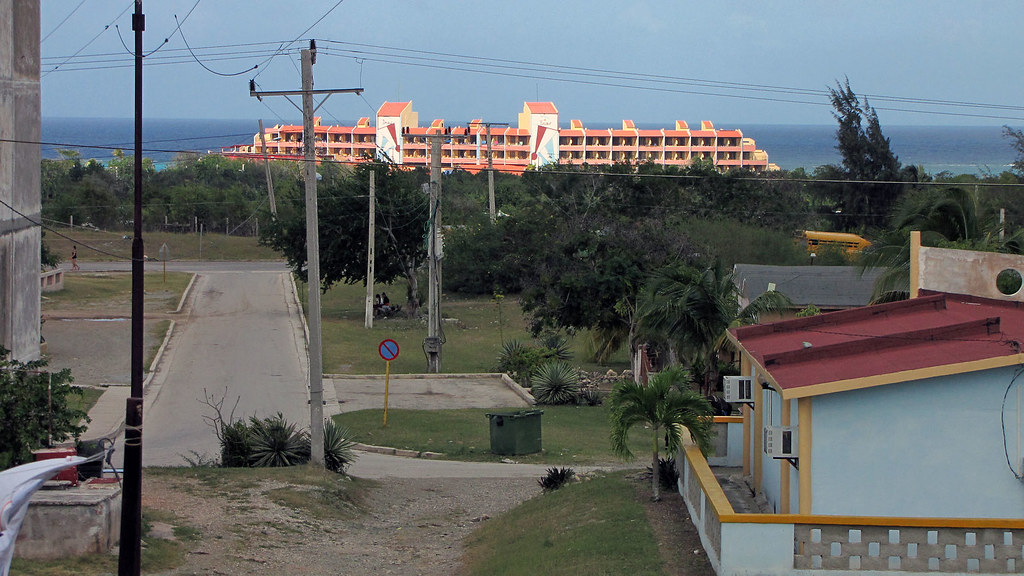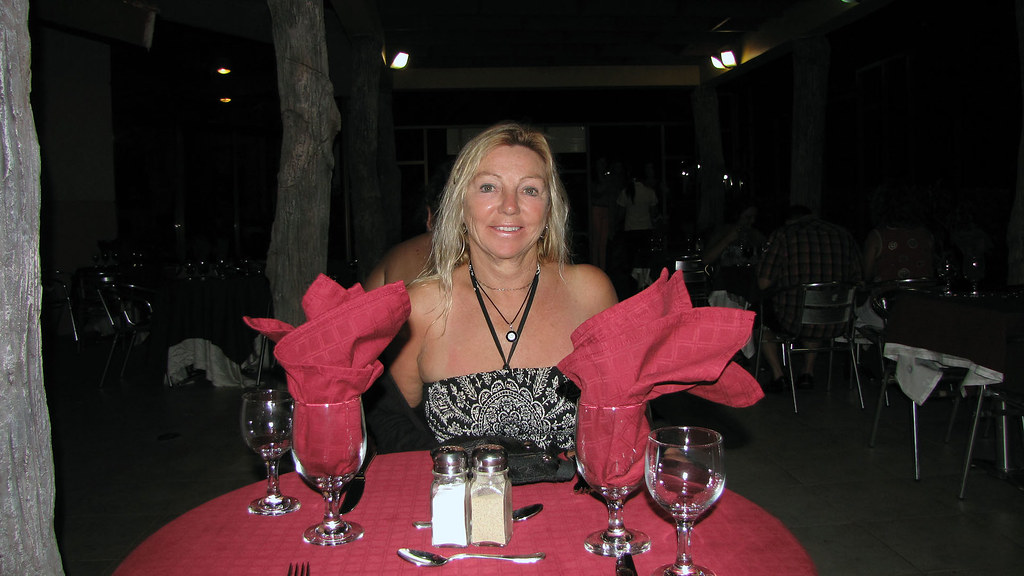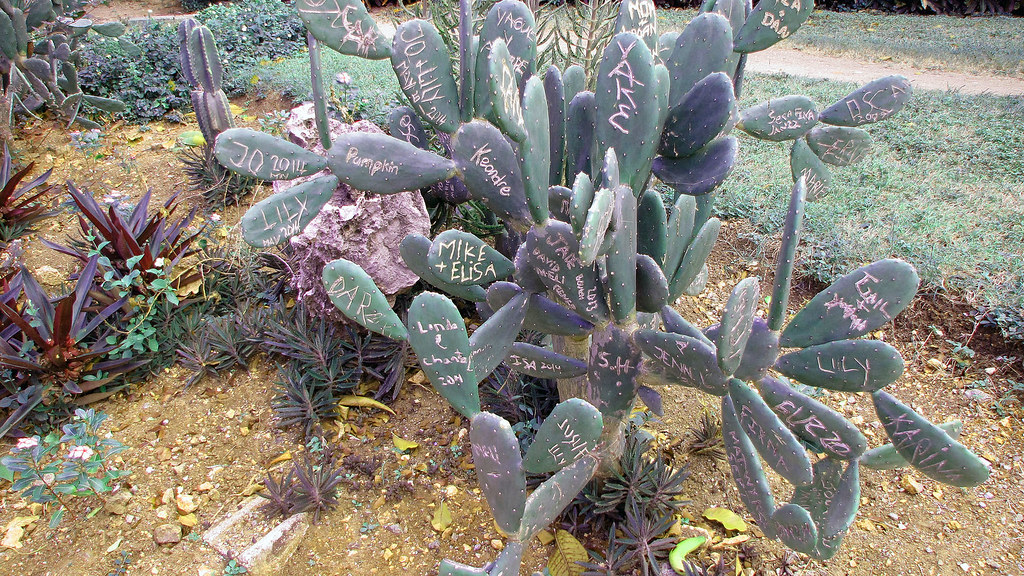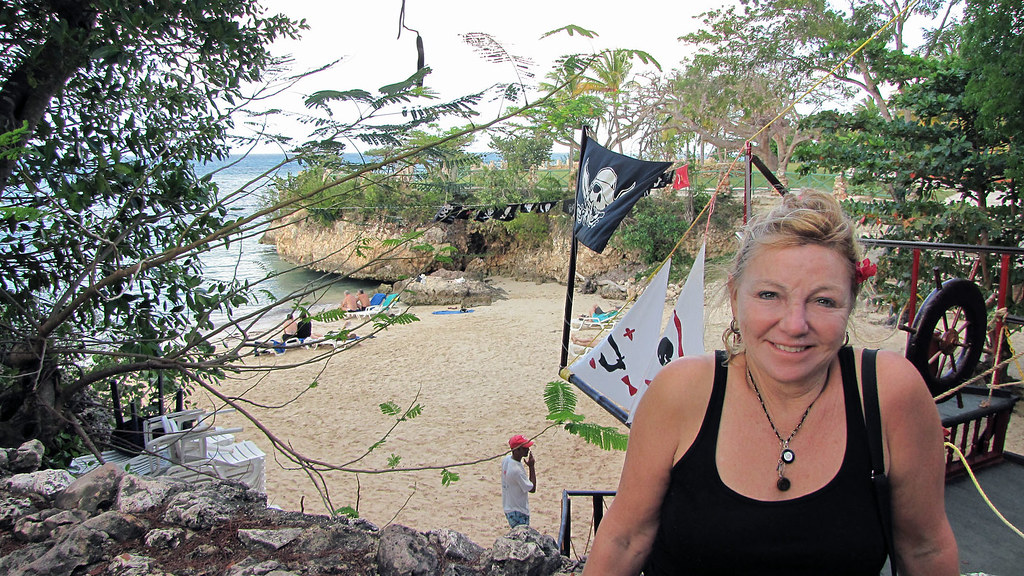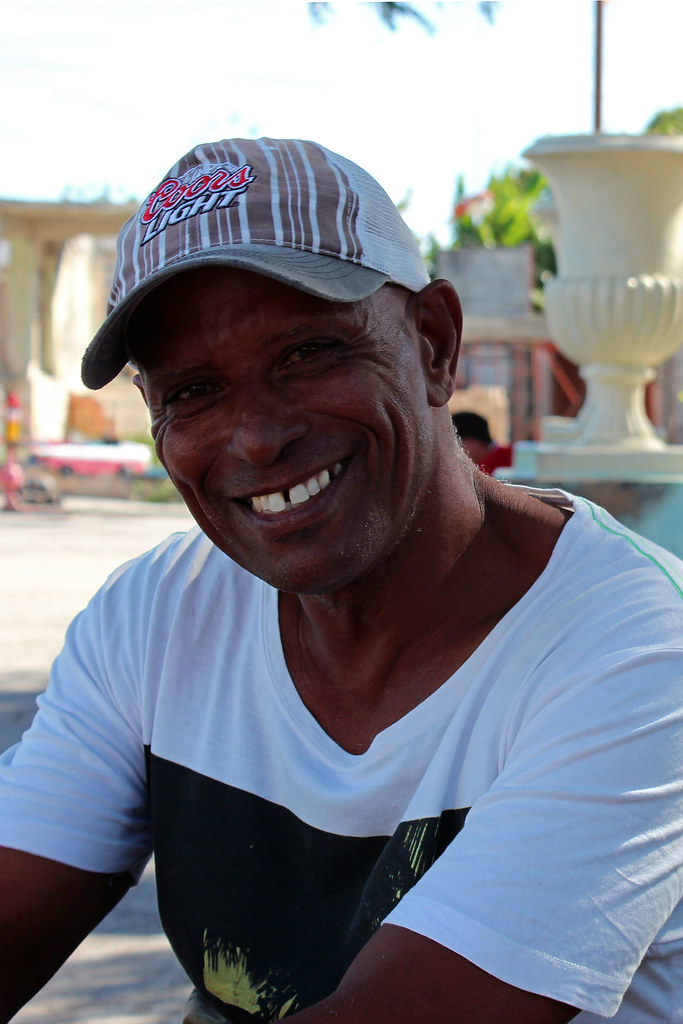Blog po polsku/in Polish: http://ontario-nature-polish.blogspot.ca/2015/12/biwakowanie-z-niedzwiedziami-i-pywanie.html
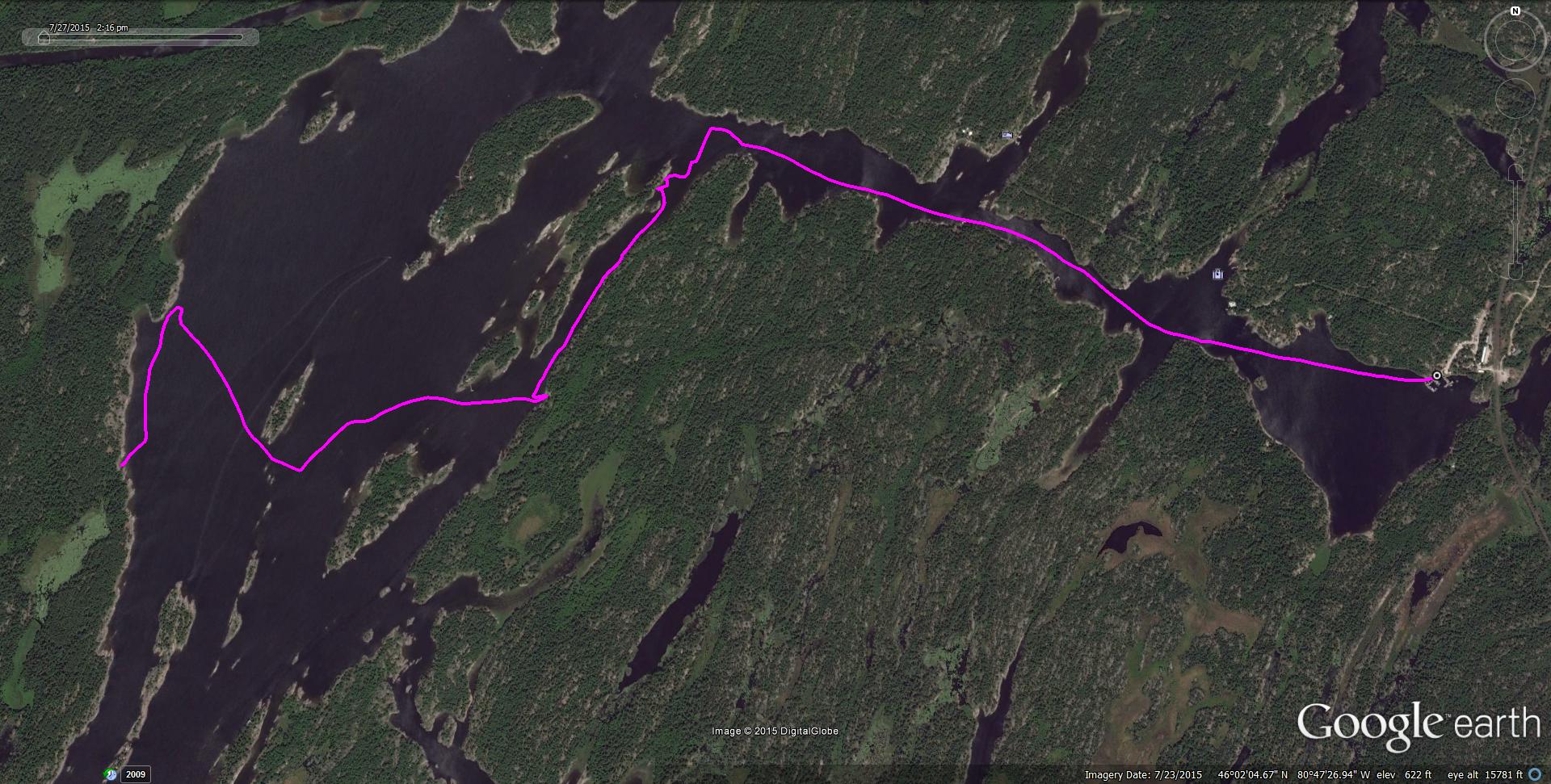 |
| Our route as per the GPS tracks |
Twenty
years ago, in August, 1995, I had spent one week camping and canoeing
on the French River—we had departed from Hartley Bay Marina,
portaged over the Dalles Rapids, reached the Bustard Islands and
after spending two nights there gone back, this time portaging over
the tramway and proceeded back to Hartley Bay. It
had been my first canoeing trip in Canada and also the
best one I had ever taken in Canada—as well as it got me hooked on
canoeing! Since then I have visited the French many times—this is a
magical area, very picturesque, containing here and there remnants of
not so distant history. Moreover, the famous French explorer, Samuel
de Champlain, had canoed on the French River in 1615; on August 1,
2015, it was exactly 400th
anniversary of Champlain's reaching Lake Huron (Georgian Bay)! So, I
was looking forward to spending a week on this magnificent river
(which, by the way, with its myriad of inlets, narrows, bays,
islands, rocky isles and polished rocky shores hardly resembles a
river at all!).
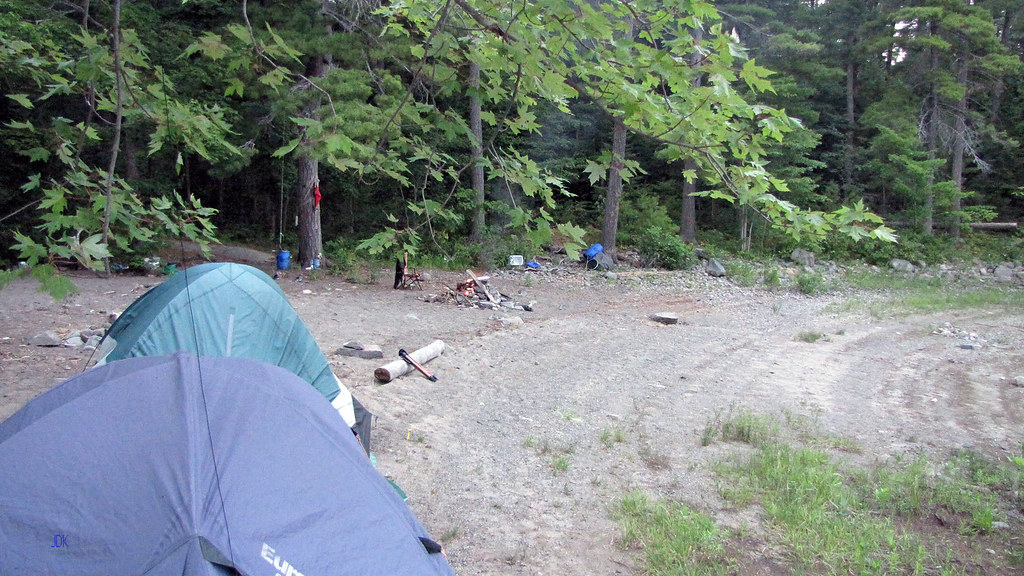 |
| Our campsite #609 on the French River (Boom Island) was very open and spacious |
A
friend of mine and I left Toronto on July 26, 2015; it was very hot,
+33C and we had air conditioning at full blast. Our first brief stop
was at King City's Tim Horton's on highway 400, where they botched up
my order—AGAIN—it had happened so many times before! Once we had
something to eat and drink, we were back on the highway and it was a
very smooth ride. North of Parry Sound we saw a steel memorial of a
drummer on the right side of the highway. In early January, 2012,
four teenagers had died on an icy stretch of highway 69. One of the
teens was Cole Howard, 19, a popular drummer of a local band. His
father, James Howard, had an artist create a likeness of Cole behind
his beloved drum kit and the sculpture was erected in 2014. In
addition, there were crosses at the site to commemorate the other
teens killed at that accident.
In
order not to rush, we decided to spend the first night camping at
Grundy Lake Provincial Park. According to Trip Advisor's most recent
reviews, there were plenty of mosquitoes as well as bears at the
park, so we brought an extra can of bug repellent. We got campsite
#113, the same Catherine and I had stayed on in 2010, before our
canoeing trip to the northern portion of the French River. A short
path led from the campsite to the lake, it was possible to sit on a
big rock and the view was quite impressive! Plenty of campers were
canoeing (no motor boats were allowed on the park's lakes) on the
lake; although the park was probably 90%+ full, it was relatively
quiet. There was a water tap just across the campsite and several
meters further away clean bathrooms. We started the fire and had
ribs. Amazingly, there were no mosquitoes at night due to the very
hot weather. Serenaded by loons, we quickly fell asleep.
 |
| Fishing station on the Bustard Island in 1896. In 2009 we found and visited this location (refer to the photo below) |
In
the morning we quickly packed up and drove to the French River
Visitors' Centre, where we spent 20 minutes looking at the displays
and learning about the local history. One of the photographs in the
Centre showed a late 19th century photograph of a commercial fishing station in the Bustard
Islands in 1896. In 2009, 113 years later, I paddled to the Bustard
Islands and located the same spot, albeit the houses, ships and
people were gone... We also got our permits at the Center—and were
informed that three campsites, number 610, 611 and 617 had been
closed due to bear activity. Guess what—we actually wanted to stay
on campsite #617!
 |
| The site of the Fishing Station on the Bustard Island in 2009, 113 years later. Houses, sailing boats and people are gone, but the rocks remain... |
Following
the visit at the Centre, we headed to the Hungry Bear Restaurant, had
coffee & a light snack—the place was teeming with tourists and
there were line-ups. In a couple of years the existing road 69 will
be made into a freeway and thus the access to this renowned
restaurant will become restricted; I hope the restaurant will survive
this change, as it has been become a very well-known landmark for
over 50 years! Satiated, we drove to Alban to do our last-minute
shopping. At the LCBO store we ran into the owner of Grundy Lake
Supply Post, from whom Catherine and I had purchased our canoe in
2010. Unfortunately, the company that used to make Scott canoes had
declared bankruptcy several years ago. I told him that it was one of
the best purchases of my life! From Alban, we drove to highway 69,
turned into Hartley Bay Road and some 20 minutes later arrived at
Hartley Bay Marina.
 |
| Kamp Kaintuck, one of the oldest camps on the French River |
The
main office was located just meters from the CNR railway and we went
there to obtain a parking permit-parking cost $10 per day plus $10
for launching. We chatted with two very nice employees a.k.a.
(co)owners who told us about campers calling the marina “that there
are bears at our campsites!” They called bears ‘overgrown
racoons” and I fully agreed with this nomenclature. I was told that
Mr. Palmer (owner), whom I had met during my first visit in 1995, was
still actively working at the marina. I quickly told them about
Celina Mroz and Jarek Frackowiak, two kayakers from Poland, who had
contacted me in 2008, inquiring about paddling on the French River.
They had arrived in Canada in 2009 with their tiny folding kayak and
paddled from Hartley Bay to Ottawa! I still remember a photograph of
both of them on Hartley Bay Marina’s docks. In 2011 they went to
Peru to paddle on the Ucayali River and were murdered in cold blood
by local Indians while kayaking on the river.
 |
| View from our campsite; it was certainly raining in Hartley Bay |
Once
we got our parking permit, we slowly drove a short distance to the
docks. I recognized the employee I had seen in 2008, who showed us
where to park the car. I also took a photograph at the same spot we
had taken a group photo in 1995. While we were loading our canoe, two
women were also preparing to commence their trip, they were planning
to paddle the Voyageur Channel (something I have to do one day) and
another couple was going to the Bustard Islands (I envied them!).
Once we were finished, I simply left the car with the key in the
ignition (yes, the marina provided valet parking) and hopped into the
canoe.
 |
| Our canoe at night |
Once
on the water, we welcomed a light breeze in this hot and humid
weather. After about 25 minutes we left Hartley Bay (I mean ‘the
bay’, NOT the marina), we entered Wanapitei Bay and quickly checked
out campsite #601 on an island. We did not like it—it was too
dark—so we proceeded to campsite #612, on the east shore of the
bay. It was better, yet we were not too keen on it either. Since the
next campsite (#613) was occupied, we crossed the bay, maneuvering
among some islands and rocks, and slowly paddled along the western
shore, eventually approaching campsite #609.
 |
| View from our campsite. Those ominous clouds made us change our mind and stay put instead of going fishing |
It
had a big, semicircular open ‘beach’ strewn with sand, rocks,
pebbles and some vegetation. However, according to various waterlines
on the rocks and on the ground, the whole site—and I mean up to 15
m from the water—must have been flooded during spring and fall
(later, the warden confirmed that), thus leaving no space to set up
tents during those seasons. There was a meadow deeper in the forest,
in a hollow, where tents could be pitched, yet due to its location,
it could also become quite damp and swampy if it rained. Since the
site was exposed, we expected less mosquitoes. It also had a couple
of fire pits and a new thunder box in the woods. Well, the two nearby
campsites, #610 and #611 were closed, so we did not feel like
paddling anymore and decided to bivouac here. Obviously, we were
aware that those campsites, located just a few hundred meters from
ours, were closed due to bear activity and that there was not any
barrier to keep the bears from moving over to our campsite, but we
did not really think much about this. So, we quickly set up two tents
on the ‘beach’ and hung the barrel and cooler (both full of food)
on a sturdy branch. Too tired to go for a paddle, we started a
campfire and had a couple of steaks. We were facing several islands
with cottages which were occupied as we soon saw lights flickering in
the windows.
 |
| Chris with our dinner, i.e., a nice pike |
Our
campsite was located on Boom Island; according to the description on
the official French River Map, “Booming out Grounds—during the
logging era, this section of the river (exactly in front of our
campsite) was used for gathering logs that were run down the rapids.
They were put in boom and towed by alligator boat down the river.”
I even found a very old rusty metal part of a machinery, likely
coming from an alligator.
From
our campsite we could see campsite #612 across the bay (which soon
became occupied) and the well-known Kentucky Club Island (2 km away),
where Kamp Kaintuck, a privately owned fishing camp, was located. It
had been the site of an annual fishing trip for a group of
Louisville, KY business and professional men since 1912.
 |
| "There is a bear at our campsite!" |
Next
day was very hot and sunny; since my tent was exposed to the morning
sun, I had no choice but wake up—or suffocate. It was really
impossible to do anything in the open, so we moved our chairs towards
the forest and sat in the shade. I brought a number of books and
while trying to pick one of them, I was suddenly startled by Chris’
(too) calm words:
“Jack,
there is a bear behind the trees!”
Indeed,
we saw a black bear—its black fur contrasted with the forest’s
green canopy. It must had been watching us for a while; then it kept
moving around behind the trees and finally faded in the forest. Just
in case, we hung the cooler and the food barrel—after all, it was
not after us, but our food (or so we hoped).
I
started reading “Phantoms” by Dean Koontz and about 30 minutes
later I saw a moving black shape in the forest—wow, another bear!
It was followed by a cuddly, small cub! So, now we had a sow with a
cub! The bears kept roaming around the campsite, but all we saw was
their black fur and moving branches or bushes; a few minutes later
they vanished in the forest without even giving me a chance of taking
a photo.
 |
| Bear rummaging through our stuff at the campsite |
Around
6:00 pm, when it finally got cooler, we jumped into the canoe and
went fishing, paddling in the southern direction. I caught a very
small pike and let it go. Then we paddled back along the shore,
constantly casting. I snagged a bigger fish, but after a brief fight
it got away before I even got a chance to take a look at it. As we
were slowly approaching our campsite, being pushed by the light wind,
I heard some clamor coming from the direction of the campsite—since
a big rock blocked the view, we kept paddling vary hard to get an
unobstructed view of the campsite—then we heard another clatter—and
finally we saw the campsite. As I suspected, there was a black bear
standing next to the transparent utility box in which we kept our
non-edible stuff. It was probably over 200 lb. and was innocently
looking at us, but quickly went about his business of sniffing at the
plastic box, its cover already removed, and with his paw tried to
poke around inside. We paddled closer and Chris came ashore, armed
with a paddle, but the bear immediately took off and disappeared in
the forest. The box had a few holes here and there, fire starters
were chewed up and a plastic bottle containing red wine had a few
cracks. We continued fishing and headed towards the small bay where
campsite #608 was located (there were two canoeists camping
there)—the bay was weedy and I thought it would be a perfect
fishing spot. I was right—in no time I caught a 4 kg pike, about 90
cm long.
We
immediately got back to the campsite—fortunately, the bear was not
there, but the box cover was again dislocated, an evident sign that
he was still hanging around the campsite. As Chris went to clean the
fish, I washed the canoe, all that time observing the area and
looking for the bear—I was afraid that he could have been attracted
by the smell of the fish and come to investigate. Yet eventually it
was not the bear that made Chris’ life miserable, but swarms of
mosquitoes—they were mercilessly attacking him and soon plenty of
horse/deer flies joined them. After he cleaned and filleted the fish,
Chris took a quick bath in the lake—again, hordes of mosquitoes
droned around him. Suddenly, he became surrounded by dozens of dragon
flies which had materialized out of the blue and were apparently
catching the mosquitoes—finally, we found allies!
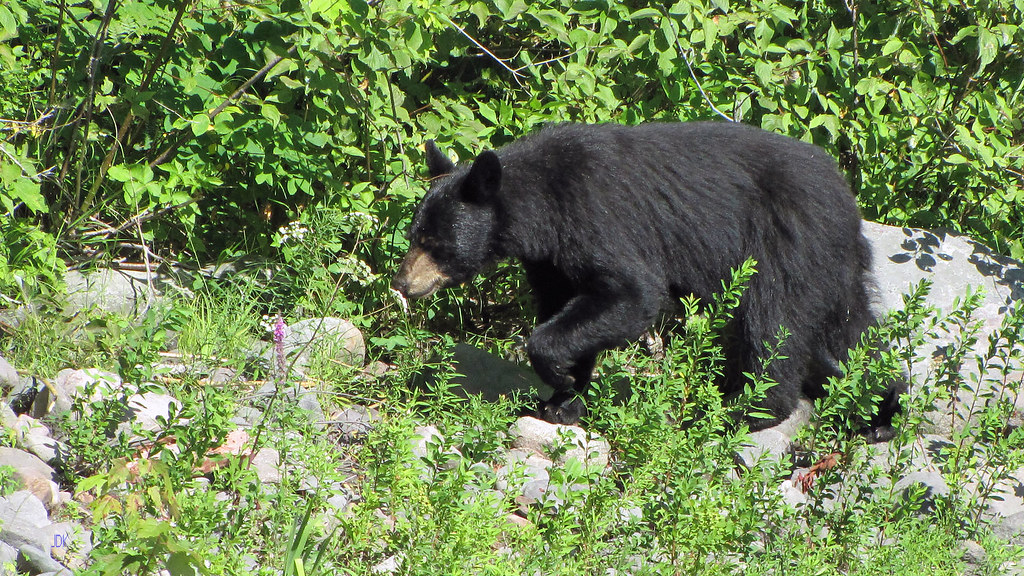 |
| The bear was very persistent, circling around the campsite |
Minutes
later we were sitting around the fire and had the last portion of the
ribs (we left the pike for tomorrow). Before turning in, we
religiously placed all the food and cosmetics into the barrel &
cooler and hung them up in the tree. Yet nothing disturbed us and
both of us slept very soundly.
Wednesday
turned out to be yet another hot and sunny day and we spent most of
the day sitting in a shaded area, reading books and magazines. Chris
found two snakes—a green snake and a small red bellied snake, both
totally harmless—as well as a few colorless hummingbirds showed up,
one of them took a particular interest in Chris' head, hovering
around it for a while.
We
saw a bear again, but it was hidden in the forest and quickly
retreated. In the late afternoon we wanted to go fishing, but the sky
became dark and soon a light drizzle turned into a pouring rain.
Well, we certainly needed rain; besides, I was afraid that should the
heat wave continued, a fire ban could be imposed, thus preventing us
from having campfires. So, we went to our tents and I read for a
while, then fell asleep.
In
the middle of the night I was awaken by an eerie cacophony of howling
and whining, apparently made by a pack of coyotes. They must have
been very close to our campsite, as the sounds were very loud. I
awoke Chris and both of us were listening to this very loud, peculiar
and surreal spectacle, which ended as abruptly as it had started.
On
Thursday, July 30, 2015, I was up at 8:00 am, but drifted back to
sleep. While in a middle of a dream, I was brought back to reality by
Chris' shouting.
“Jack,
there is a bear next to your tent!”
As
I was hastily getting dressed, he was telling me that the bear just
headed to the shore.
“OK”,
I thought, “the danger is over,” and decided to stay in the tent,
but two minutes later I was once again roused by Chris' yelling.
“There
is the sow with the cub here!”
Well,
I can’t get any sleep here,
I thought and got out of the tent. Indeed, I saw it and a cuddly cub
on the beach and they were going to the forest towards a small
meadow. The bears quickly vanished in the forest and again, I had no
chance to take a picture of the cub.
I
walked towards the forest, sat in the chair and drank my tea, when I
heard Chris again.
“Look,
there is a bear on the rocks, on the other site of the campsite!”
Indeed,
a medium size bear (probably the same one we had seen before) was
slowly walking on the rock formations towards our barrel which we had
just lowered to get food for breakfast—exactly where we were
sitting. I snapped several photos as the bear was slowly moving
towards us. Then I stood up and in a very assertive tone of voice,
shouted something. It stopped, gave me a nasty look and turned back
into the forest—but a minute later popped up again and was
wandering on the rocks nearby for some time, only to fade into the
forest.
 |
| The bear was quit bold and kept watching us, hoping that once we are gone, he can put things in (his) order! |
Finally
I had my tea and we talked about all the excitement we had in such a
short period of time—and then I saw a bear again, staring at us,
its black head clearly contrasting with the forest's green canopy. It
was the sow, followed by the small adorable cub—presumably the same
ones we had seen two days before and in the morning. They kept
looking at us, then slowly walked to the rocks and finally retreated
to the forest, with the adorably looking cub awkwardly following her.
Wow, I had never seen so many bears in the wild in my life before
(except at garbage dumps), let alone on an interior campsite!
We
kept reading books and at 4:00 pm we went paddling: first to the
campsite on the left (#608), then to a bay with two campsites, #614 &
615, both were vacant. The other campsite, #616, was occupied. We
wanted to paddle to campsite #617 (the closed one, which I wanted to
stay on—our group had stayed on it in 2009 during our trip to the
Bustard Islands), but it was so windy that we remained in the bay for
a while. There was a small inlet in the bay and we paddled there; I
cast and caught a small pike, just perfect for supper! Pushed by the
wind, we slowly drifted back towards our campsite, passed it by and
ended up near campsite #608, where Chris caught a small pike, but let
it go. While approaching our campsite, I noticed that there was
something blue on the ground—but since the barrel and the cooler
were still safely handing, I did not think much about it. Once we got
ashore, I realized that the blue object was our cooler's lid! To make
the story short, the bear must have climbed the tree and although the
cooler was hanging about 1 m from the tree’s trunk, it still
succeeded in removing the lid and tossed out several bottles full of
tap water (which we had frozen and placed inside the cooler—there
was still some ice in them). Except for the bottles, there was just
one other thing in the cooler—a box with dew worms—the bear
pulled it out, but most of the worms remained inside the cooler. Once
I lowered the cooler, I saw a number of tooth marks on its walls (in
addition to the tooth mark made by another bear on our campsite in
Algonquin Park in 2011).
The
bear also punctured our water bottles (which were left on the
ground), once more ‘inspected’ the plastic box that contained
strictly non-edible stuff, such as paper towels, paper coffee cups,
plates and damaged many of them—as well as damaged the box itself.
In addition, it punctured two of our 4 l jugs full of spring water.
It was a miracle that it had not gone into our tents! The barrel,
where we kept all of our food, was safely hanging on the tree branch
and was undamaged—it could not reach it.
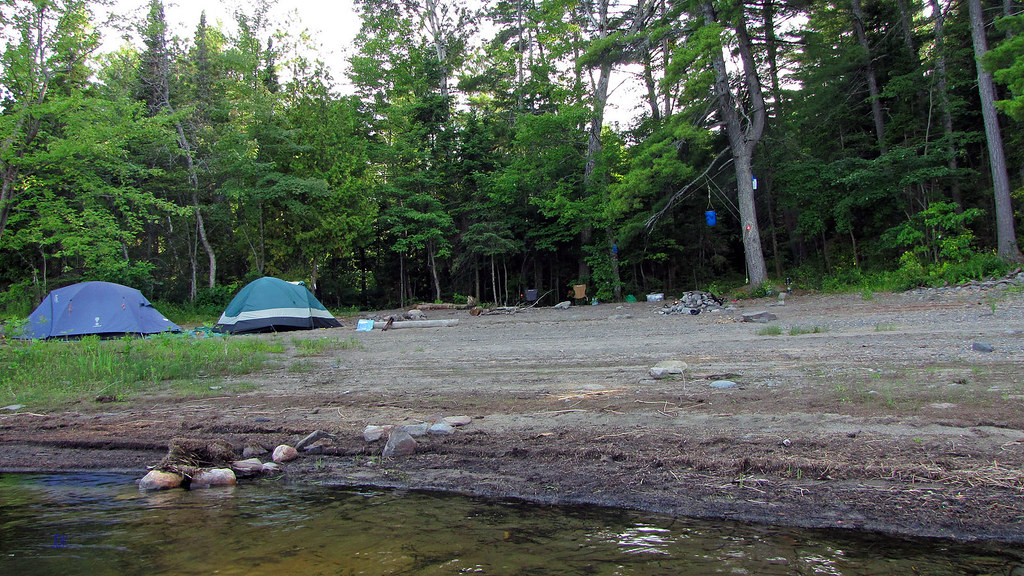 |
| Our campsite #609 |
We
had brought several cans of bug spray with us. One can was in the
plastic box—and we found it empty, with three holes, apparently
made by the bear’s teeth. Considering that it was a pressurized
container, when the bear bit it, the can must have exploded right
into its face, spraying it with the rather unpleasant substance
containing 30% of DEET. Since it was the last time we saw that bear
at our campsite, we came to a conclusion that most likely the
encounter with the bug spray was so unpleasant and literally
unpalatable that the bear decided to keep away from our campsite for
good. Well, maybe next time we would bring some pressurized cans of
foul smelling stuff and purposefully leave them for a bear to bite
at—that might be the best and harmless bear deterrent!
Chris
patched up several of the bottles and jugs with the masking tape and
managed to save some of the water. We had a water filter, but we did
not want to use it, preferring mineral or tap water that we brought
with us.
Chris
cleaned the fish, I minced carrot, garlic and onions, stuffed the
fish, wrapped it in aluminum foil and grilled it over the fire—it
was delicious! We sat around the fire for a while and went to bed
past midnight. We also admired the full moon—it was also the blue
moon, the second moon of the month.
 |
| The bear tried to approach the campsite from the water |
Friday
was noticeably cooler, but we did not mind this change in the weather
at all. We were up at 10 am and there was no bear activity at night,
or at least we were aware of any. We wanted to paddle to Hartley Bay
Marina, but noticed ominous black clouds and occasional lighting, so
we decided to stay put. At one point we spotted, several dozen meters
in the forest, the sow with the cub, but they kept away from us and
almost immediately disappeared. Not long after it started raining; we
sneaked into the tents and fell asleep, waking up before 6:00 pm,
when the rain ended. For some time we were fishing off the rock near
the campsite (the same rocks favored by the bear). Again, dark clouds
were forming over the Hartley Bay area and it was probably raining
there. Soon, we saw lighting and heard thunders. Suddenly it became
windy and as we were ready to seek shelter, Chris caught a sizable
pike, but because of the pouring rain, he did not have the time to
clean it and just left it on a rock as we rushed to the tents. Soon
it was pouring as well as a storm blew up, accompanied by lighting
and thunders.
Saturday,
August 1, 2015, marked the 400th
anniversary of Samuel de Champlain's arriving at Lake Huron (Georgian
Bay) after his journey on the French River (he must have paddled
several km from the location of our campsite); we heard on the radio
about local commemorations of this historical event. It was also the
71st
anniversary of the outbreak of the Warsaw Uprising of 1944, which
lasted for 63 days.
As the weather was
good, we paddled to Hartley Bay, passing Kentucky Club Island, but Kamp
Kaintuck appeared to be empty at that time. There was plenty of activity at
Hartley Bay Marina; we did not have much stuff, so we quickly unpacked, the
marina employee brought the car and let us put the canoe on the canoe rack on
the dock. We drove to Noëlville, a small town where most inhabitants were of
French origin and spoke French (and English), although I was told that
sometimes they had a hard time understanding French-speaking people from Quebec
and France. We went shopping to the supermarket and then to the LCBO store.
There was a small dollar store and I chatted with its owner for a while about
vacationing in the Dominican Republic, as she went there every year. Later we
stopped at the Hungry Bear restaurant where Chris had a cup of coffee, then
drove to Hartley Bay Marina, launched the canoe and were on our way to the
campsite. It was windy and of course, we were paddling against the wind! The
most difficult stretch was crossing Wanapitei Bay; the waves were quite high,
yet it was the head wind that made it very arduous to move forward—even though
we were paddling hard, our speed was 3 km/h. Once we reached the campsite, we
had delicious cold been and were glad to see no signs of bear rummaging. Chris
caught another pike from the shore and we promptly had it for supper. We sat
around the fire until 1 am; from time to time we could hear passing trains,
which were blaring their whistle very loudly, its sound propagating for miles.
I took a lot of photographs of the full moon and the canoe, using a strong
flashlight.
Sunday
was cloudy, but nice. We spent time reading and relaxing. I finished
my book (“Phantoms” by Dean Koontz) and found it quite good, then
started reading “The Nurse's Story” by Carol Gino, which was very
touching and informative. For the first time in 2 days we had not had
a bear sighting—we almost missed NOT seeing one, as we had gotten
so accustomed to them—even forgave the buster that had damaged our
possessions! Chris caught a sizable Walleye from the shore, cleaned
it and as we were preparing to fry it, it started to rain and we put
it in the cooler and went to bed without having a campfire. It rained
very heavily at night.
 |
| Ready to depart! |
Finally
came Monday, August 3, 2015, our last day on the French River. We
were up at 9:30 am and started to pack—first of all, we had to dry
the tents and tarps, so we spread everything out in the sun all over
the campsite. A motor boat arrived at the campsite with two park
wardens. Actually, it was the first time I ever saw wardens at the
park—sometimes I wished they had patrolled the park more often, as
some of the campsites we had camped on in the past were such a mess,
with broken beer bottle glass everywhere and fire pits full of
garbage. They quickly inspected the campsite. I told one of them
about the bears and even showed photos and videos; he said it was
quite a big bear (although I had seen much bigger) and also said that
there had been problems with bear activity at other campsite, campers
were complaining about the sow with the cub. I also asked them about
all the fallen trees near the thunder box—they had been felled 8
years ago during a violent storm. The wardens confirmed that in fall
and spring the whole campsite was flooded. We were asked to show the
camping permit—although I had always bought one, I was told by
quite a few campers that they never bothered to get one as it was
very unlikely to encounter a warden in the park. They said that so
far, all the campers they had checked had valid permits. Eventually,
the warden affixed a new sign to the tree just below the sign with
the campsite number: “Campsite Closed.” Yes, it was due to all
the bear activity! I wished I could have talked to them longer, but
they were in a hurry and quickly left. Before departing, we fried the
walleye Chris caught yesterday; whereas pike was very good, the
walleye was absolutely delicious!
It
took us just under one hour to arrive at Hartley Bay Marina, which
was teeming with activity, some people were coming, others leaving,
and it was difficult to find a spot to moor the canoe at the dock.
However, the marina’s employees were very well organized—one of
its trucks had a towing hitch installed in the front so that it could
easily tow boat trailers. I paid for the parking and Chris was
gradually bringing our equipment. Ten minutes later my car was
brought and parked at the loading/unloading area, we quickly loaded
it and left for Noëlville.
Unfortunately,
the supermarket was closed (it was a long weekend Monday) and we
drove to Alban, where we went to a grocery store called “Lemieux,”
bought several steaks, then paid a quick visit to the LCBO store and
drove back to the Hungry Bear restaurant. There was an accident on
the highway, one car was overturned and rested on its roof, another
damaged—but I think nobody was seriously injured. Chris had coffee
at the restaurant and I spent 30 minutes at the Trading Post, mostly
browsing the book section—some of the books on the French River
were awesome! Then we drove to Grundy Lake Provincial Park; almost
all campsites were occupied and we were given a choice of 3—we
spent some time checking them out and picked #152—it had an
impressive old pine tree and we noticed there were similar massive
pines at other campsites, too. Although there were campers at
adjacent sites, we hardly noticed them. We did not see any bears (not
that they would have scared us at all after our French River bear
encounters), but plenty of very inquisitive birds kept coming to the
campsite, trying to look for and steal our food.
Again,
mosquitoes were not too bad and at night we were serenaded at night
by loons—something truly unforgettable! Unfortunately, we did not
have time to canoe on Grundy's four lakes, which do not allow any
motorized boats and thus are very quiet.
 |
| Campsite #152 at Grundy Lake Provincial Park |
Grundy
is a big park, with many campgrounds, some catering mostly to
recreational vehicles (RVs), others to RVs and tents, so the level of
privacy might vary considerably, depending on the campground. It is a
good idea to either do some research online before making a
reservation or drive in the park for an hour or so to pick the most
appropriate campsite.
The
park offered plenty of activities—we went to the soapstone carving
workshop at the Picnic Shelter. Participants could buy a piece of
soapstone for $2-$60 and then turn it into a canoe, bear, heart or
many other objects—tools were provided. It was amazing that even
kids created impressive, shining carvings—it was an excellent idea
to let people experience this activity! After all, similar soapstone
carvings can cost hundreds of dollars. I wished I had tried to carve
something, but knowing my manual dexterity, I was unwilling to try.
Although
I heard on the radio that as a result of the hot and sunny weather
‘professional’ blueberry pickers had a very tough time finding
blueberries, on Tuesday morning I decided to take Chris to my
'secret' spot, where last year blueberries were so plentiful that in
no time the 4 liter jug became full of them! We took highway #69 and
then road #529; as we were driving on the latter, we did not see any
homes, just were surrounded by wilderness! From time to time we saw
signs saying 'Fire ban-no open fires'—but I guess they had just
become obsolete as it was pouring while we were there. Finally we
arrived at our destination... and what a disappointment! Most of
blueberry bushes were totally baked by the sun, its leaves dry and
blacken, as if incinerated by a torch! There were some berries, yet
very small and dry, totally unpalatable. After wandering for 15
minutes, we managed to pick just a handful of blueberries.
According to statistics and
research in Ontario, human-bear occurrences (ranging from sightings to
contacts) fluctuate with the availability of food in the wild. When bears have
trouble finding food in the forest—and the lack of blueberries constitutes a
food failure—they come out, looking for food and visit, among other places,
campsites. Thus, it could be the explanation why we had seen so many bears on
our campsite!
Disillusioned,
we headed to Pointe au Barril where we had a slice of pizza and
poutine, proceeded to the town's main store, got a piece of pork for
tonight's barbecue and headed back to the park, which apparently had
not gotten any rain. Our 'neighbors' had left and we could enjoy
plenty of privacy. In the evening we put the meat on the grill—and
then it started to rain! We sat under the impressive pine, which did
provide some protection against the rain. I donned the rain-gear and
from time to time checked on the steaks. Once they were cooked, we
had them and quite frustrated, sneaked into the tent. It kept raining
on and off the whole night.
On August 5, 2015 we got up in the morning; the tent
was still wet and we decided to dry it later at home instead of wasting time at
the campsite. We made a quick stop at Pointe au Barril and drove to Parry
Sound, where we went to “No Frills,” bought fresh salad, bread, feta cheese and
mineral water for our lunch. We also checked out “Hart”, but did not find
anything interesting.
We headed to the town's waterfront, where under the
train trestle over the Sequin River, on the old Chippewa docks, we had our
lunch. I wanted to show Chris the plaque Catherine and I had seen last year,
depicting Tom Thomson's painting of the trestle made in 1914, but could not
find it. One lady told me it had been vandalized! I also spoke to Keith
Saulnier, the owner of Georgian Bay Airways Ltd. that provided air tours of the
area (I had taken such a tour in the 1990s and it was awesome!). I thought
about hiring a plane, along with 2 other people, in order to take aerial
photographs of the Massasauga Park, Franklin Island, the Thirty Thousand
Islands and other places I had visited by canoe. We also spoke to a fellow on a
big cruising motor yacht—its tank held up to 500 gallons of gas and used about
1.5 gallons per mile. A very impressive—and expensive boat! There was a big
speed boat, which could be probably compared to a sports car—its main purpose
was to go very fast. We also took a look at other interesting boats moored at
the docks. I showed Chris the Center for Performing Arts, but we did not have
time to go inside. Drive home was problem free; before Toronto, I took the toll
road and thus avoided the rush hour traffic.
I wish we
could have done more canoeing and explored other parts of the French
River. Yet we caught plenty of fish and the highlight of the trip was
undoubtedly the numerous bear visits, we will certainly remember them
for a long time!
Blog po polsku/in Polish: http://ontario-nature-polish.blogspot.ca/2015/12/biwakowanie-z-niedzwiedziami-i-pywanie.html









